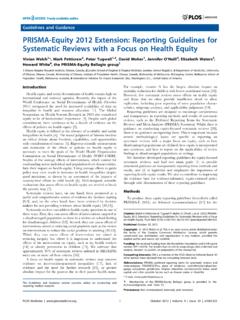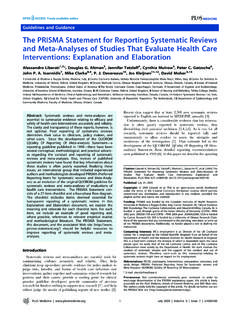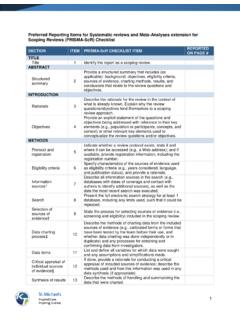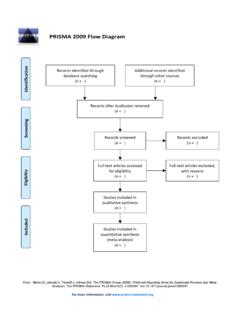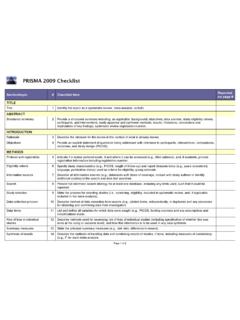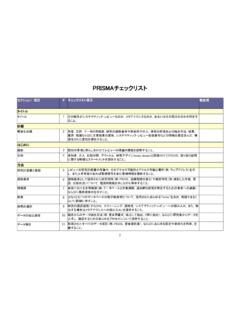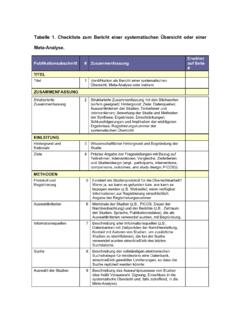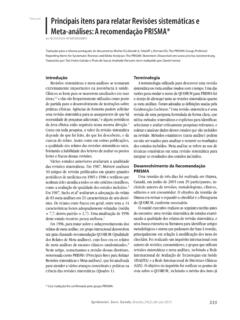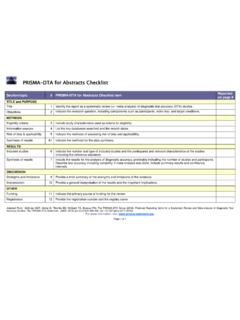Transcription of PRISMA-E 2012 Checklist
1 PRISMA-E 2012 Checklist Checklist of Items for reporting equity -Focused Systematic Reviews Section Item Standard PRISMA Item extension for equity -Focused Reviews Pg #. Title Title 1 Identify the report as a systematic review, meta-analysis, or both. Identify equity as a focus of the review, if relevant, using the term equity Abstract Structured 2 2. Provide a structured summary including, as applicable: background; objectives; State research question(s) related to health equity . summary data sources; study eligibility criteria, participants, and interventions; study appraisal and synthesis methods; results; limitations; conclusions and implications of key findings; systematic review registration number. 2A Present results of health equity analyses ( subgroup analyses or meta-regression).
2 2B Describe extent and limits of applicability to disadvantaged populations of interest. Introduction Rationale 3 Describe the rationale for the review in the context of what is already known. Describe assumptions about mechanism(s) by which the intervention is assumed to have an impact on health equity . 3A Provide the logic model/analytical framework, if done, to show the pathways through which the intervention is assumed to affect health equity and how it was developed. Objectives 4 Provide an explicit statement of questions being addressed with reference to Describe how disadvantage was defined if used as criterion in the review ( for participants, interventions, comparisons, outcomes, and study design (PICOS). selecting studies, conducting analyses or judging applicability).
3 4A State the research questions being addressed with reference to health equity Methods Protocol and 5 Indicate if a review protocol exists, if and where it can be accessed ( , Web registration address), and, if available, provide registration information including registration number. Eligibility criteria 6 6. Specify study characteristics ( , PICOS, length of follow-up) and report Describe the rationale for including particular study designs related to equity research characteristics ( , years considered, language, publication status) used as criteria questions. for eligibility, giving rationale. 6A Describe the rationale for including the outcomes - how these are relevant to reducing inequity. Information 7 Describe all information sources ( , databases with dates of coverage, contact Describe information sources ( health, non-health, and grey literature sources) that sources with study authors to identify additional studies) in the search and date last were searched that are of specific relevance to address the equity questions of the searched.
4 Review. Search 8 Present full electronic search strategy for at least one database, including any limits Describe the broad search strategy and terms used to address equity questions of the used, such that it could be repeated. review. Study selection 9 State the process for selecting studies ( , screening, eligibility, included in systematic review, and, if applicable, included in the meta-analysis). Data collection 10 Describe method of data extraction from reports ( , piloted forms, independently, process in duplicate) and any processes for obtaining and confirming data from investigators. Data items 11 List and define all variables for which data were sought ( , PICOS, funding sources) List and define data items related to equity ,where such data were sought ( using and any assumptions and simplifications made.)
5 PROGRESS-Plus or other criteria, context). Risk of bias in 12 Describe methods used for assessing risk of bias of individual studies (including individual studies specification of whether this was done at the study or outcome level), and how this information is to be used in any data synthesis. Summary 13 State the principal summary measures ( , risk ratio, difference in means). measures Synthesis of 14 Describe the methods of handling data and combining results of studies, if done, Describe methods of synthesizing findings on health inequities ( presenting both results including measures of consistency ( , I2) for each meta-analysis. relative and absolute differences between groups). Risk of bias 15 15. Specify any assessment of risk of bias that may affect the cumulative evidence Page 1 of 2.
6 PRISMA-E 2012 Checklist across studies ( , publication bias, selective reporting within studies). Additional 16 Describe methods of additional analyses ( , sensitivity or subgroup analyses, Describe methods of additional synthesis approaches related to equity questions, if analyses meta-regression), if done, indicating which were pre-specified. done, indicating which were pre-specified Results Study selection 17 Give numbers of studies screened, assessed for eligibility, and included in the review, with reasons for exclusions at each stage, ideally with a flow diagram. Study 18 For each study, present characteristics for which data were extracted ( , study Present the population characteristics that relate to the equity questions across the characteristics size, PICOS, follow-up period) and provide the citations.
7 Relevant PROGRESS-Plus or other factors of interest. Risk of bias 19 Present data on risk of bias of each study and, if available, any outcome level within studies assessment (see item 12). Results of 20 For all outcomes considered (benefits or harms), present, for each study: (a) simple individual studies summary data for each intervention group (b) effect estimates and confidence intervals, ideally with a forest plot. Synthesis of 21 Present results of each meta-analysis done, including confidence intervals and Present the results of synthesizing findings on inequities (see 14). results measures of consistency. Risk of bias 22 Present results of any assessment of risk of bias across studies (see Item 15). across studies Additional 23 Give results of additional analyses, if done ( , sensitivity or subgroup analyses, Give the results of additional synthesis approaches related to equity objectives, if analysis meta-regression [see Item 16]).
8 Done, (see 16). Discussion Summary of 24 Summarize the main findings including the strength of evidence for each main evidence outcome; consider their relevance to key groups ( , healthcare providers, users, and policy makers). Limitations 25 Discuss limitations at study and outcome level ( , risk of bias), and at review-level ( , incomplete retrieval of identified research, reporting bias). Conclusions 26 Provide a general interpretation of the results in the context of other evidence, and Present extent and limits of applicability to disadvantaged populations of interest and implications for future research. describe the evidence and logic underlying those judgments. 26A Provide implications for research, practice or policy related to equity where relevant ( types of research needed to address unanswered questions).
9 Funding Funding 27 Describe sources of funding for the systematic review and other support ( , supply of data); role of funders for the systematic review. From: Source: Welch V, Petticrew M, Tugwell P, Moher D, O'Neill J, Waters E, White H, and the PRISMA- equity Bellagio Group. ( 2012 ) PRISMA- equity 2012 extension : reporting Guidelines for Systematic Reviews with a Focus on Health equity . PLoS Med 9(10): e1001333. For more information: Page 2 of 2.
